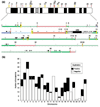Hotspots of mammalian chromosomal evolution
- PMID: 15059256
- PMCID: PMC395782
- DOI: 10.1186/gb-2004-5-4-r23
Hotspots of mammalian chromosomal evolution
Abstract
Background: Chromosomal evolution is thought to occur through a random process of breakage and rearrangement that leads to karyotype differences and disruption of gene order. With the availability of both the human and mouse genomic sequences, detailed analysis of the sequence properties underlying these breakpoints is now possible.
Results: We report an abundance of primate-specific segmental duplications at the breakpoints of syntenic blocks in the human genome. Using conservative criteria, we find that 25% (122/461) of all breakpoints contain > or = 10 kb of duplicated sequence. This association is highly significant (p < 0.0001) when compared to a simulated random-breakage model. The significance is robust under a variety of parameters, multiple sets of conserved synteny data, and for orthologous breakpoints between and within chromosomes. A comparison of mouse lineage-specific breakpoints since the divergence of rat and mouse showed a similar association with regions associated with segmental duplications in the primate genome.
Conclusion: These results indicate that segmental duplications are associated with syntenic rearrangements, even when pericentromeric and subtelomeric regions are excluded. However, segmental duplications are not necessarily the cause of the rearrangements. Rather, our analysis supports a nonrandom model of chromosomal evolution that implicates specific regions within the mammalian genome as having been predisposed to both recurrent small-scale duplication and large-scale evolutionary rearrangements.
Figures


References
Publication types
MeSH terms
Grants and funding
LinkOut - more resources
Full Text Sources

